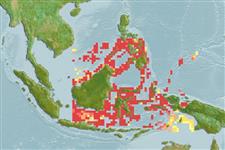Common names from other countries
Environment: milieu / climate zone / depth range / distribution range
Écologie
. Tropical; 23°C - 30°C (Ref. 102835); 13°N - 9°S, 109°E - 139°E (Ref. 106696)
Western Central Pacific: Restricted in the tropical western Pacific. From Sabah, Malaysia to Palau, north to Philippines and south to Indonesia.
Length at first maturity / Taille / Poids / Âge
Maturity: Lm ? range ? - ? cm Max length : 41.1 cm SHL mâle / non sexé; (Ref. 117184); common length : 20.0 cm SHL mâle / non sexé; (Ref. 348)
Description synthétique
Morphologie
Its shell is thinner and smoother than that of H. hippopus, usually devoid of pigmentation, and more semi-circular in profile. The mantle is similar to that of H. hippopus (Rosewater, 1982), except that prominent papillae line the margins of the incurrent siphon.
Collected for food and shell (Ref. 348). Found in shallow waters. Young specimens often byssally attached to coral heads, mature specimens lack a byssus and lay unattached on the substrate (Ref. 348).
Life cycle and mating behavior
Maturité | Reproduction | Frai | Œufs | Fécondité | Larves
Broadcast spawners. Life cycle: Embryos develop into free-swimming trocophore larvae, succeeded by the bivalve veliger, resembling a miniature clam (Ref. 833).
Poutiers, J.M. 1998. (Ref. 348)
Statut dans la liste rouge de l'IUCN (Ref. 130435)
statut CITES (Ref. 108899)
Not Evaluated
Menace pour l'homme
Harmless
Utilisations par l'homme
Pêcheries: commercial
FAO - Aquaculture: production; | FishSource | Sea Around Us
Outils
Sources Internet
Estimates based on models
Résilience
Faible, temps minimum de doublement de population : 4,5 à 14 années (K=0.13).
Vulnérabilité
Low to moderate vulnerability (30 of 100).
Catégorie de prix
Unknown.
